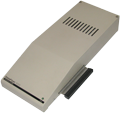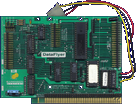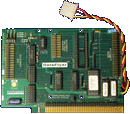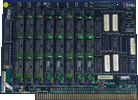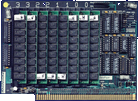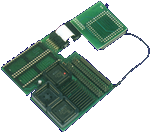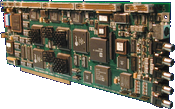Search Result
14 expansions found
Company Expansion Systems, USA | Date 1991 | Amiga A1000 | Interface side expansion port |
- SCSI or IDE controller
- the case contains a standard Zorro II DataFlyer 2000 SCSI or IDE controller card and optionally a DataFlyer RAM board
- place for a 3.5" HD inside the case, underneath the two Zorro II cards
- connects to the side expansion port - no passthrough connector
- DataFlyer 1000 SCSI:
- AMD 5380 SCSI controller
- 50 pin internal SCSI header
- optional external DB25 connector
- DataFlyer 1000 IDE:
- 40 pin internal IDE header
- hard disk activity LED on front of the case
- optional internal power supply:
- mounts inside the DataFlyer 1000 case
- provides power for the controller card, memory card and the hard disk
- turns on automatically when the A1000 is powered up
- automatically senses all international input voltages
- optional external power supply
- powers the memory card only
- has to be turned on manually before the A1000 is powered up
- separate versions for different international input voltages
- the unit can also take power from the A1000 without using an additional power supply
- autoboot ROM (ExpSys.device) - autobooting requires at least Kickstart 1.3, otherwise it has be disabled with a jumper
- autobooting can be also disabled by holding down the left mouse button during the boot sequence
- RDB compatible
- A-Max II driver (ExpSys.amhd)
Company Expansion Systems, USA | Date 1994 | Amiga A1200 | Interface IDE header |
- SCSI controller
- mounts onto the IDE header
- converts the signals on the IDE header to also run SCSI devices at the same time
- operates up to five SCSI devices (ID 0 and 1 are reserved for the two IDE devices, ID 2-7 are for SCSI)
- cannot autoboot SCSI drives (ExpXDS.device)
- IDE passthrough for the original IDE drives
- DB25 external SCSI connector
Company Expansion Systems, USA | Date 1990 | Amiga A2000, A3000, A4000 | Interface Zorro II |
- SCSI controller
- AMD 5380 SCSI controller
- 50 pin internal SCSI header
- optional external DB25 connector
- half length card with optional hard frame
- place for a 3.5" hard disk either on the back of the card or on the optional hard frame
- hard disk power connector
- hard disk activity LED connector, individual for SCSI and IDE
- expansion header for the optional DataFlyer RAM board
- autoboot ROM (ExpSys.device) - autobooting requires at least Kickstart 1.3, otherwise it has be disabled with a jumper
- autobooting can be also disabled by holding down the left mouse button during the boot sequence
- RDB compatible
- A-Max II driver (ExpSys.amhd)
Company Expansion Systems, USA | Date 1994 | Amiga A4000 | Interface IDE header |
- SCSI controller
- mounts onto the back expansion panel and connects to the IDE header with a ribbon cable
- converts the signals on the IDE header to also run SCSI devices at the same time
- operates up to five SCSI devices (ID 0 and 1 are reserved for the two IDE devices, ID 2-7 are for SCSI)
- cannot autoboot SCSI drives (ExpXDS.device)
- IDE passthrough for the original IDE drives
- DB25 external SCSI connector
- 50 pin internal SCSI header
- DataFlyer4000-12e.dms
install disk v1.2E
427 kB
Company Expansion Systems, USA | Date 1991 | Amiga A500 | Interface side expansion port |
- SCSI or IDE controller
- the case contains a standard Zorro II DataFlyer 2000 SCSI or a DataFlyer Plus SCSI/IDE controller card and optionally a DataFlyer RAM board
- place for a 3.5" HD inside the case, behind the two Zorro II cards
- connects to the side expansion port - no passthrough connector
- DataFlyer 500 SCSI:
- AMD 5380 SCSI controller
- 50 pin internal SCSI header
- optional external DB25 connector
- DataFlyer 500 IDE:
- 40 pin internal IDE header
- hard disk activity LED on top of the case
- optional internal power supply:
- mounts inside the DataFlyer 500 case
- provides power for the controller card, memory card and the hard disk
- turns on automatically when the A500 is powered up
- automatically senses all international input voltages
- optional external power supply
- powers the memory card only
- has to be turned on manually before the A500 is powered up
- separate versions for different international input voltages
- the unit can also take power from the A500 without using an additional power supply
- autoboot ROM (ExpSys.device) - autobooting requires at least Kickstart 1.3, otherwise it has be disabled with a jumper
- autobooting can be also disabled by holding down the left mouse button during the boot sequence
- RDB compatible
- A-Max II driver (ExpSys.amhd)
Company Expansion Systems / BSC, USA | Date 1992 | Amiga A500 | Interface side expansion port | Autoconfig ID 8290 / 1,2 |
- SCSI and IDE controller
- unlike the DataFlyer 500 (not Express), this unit does not use the DataFlyer 2000 and DataFlyer RAM Zorro II cards, but a single custom designed circuit board
- 40 pin internal IDE header
- 50 pin internal SCSI header
- DB25 external SCSI connector
- place for a 3.5" hard disk inside the case
- hard disk activity LED on top of the case
- autoboot ROM, autobooting requires at least Kickstart 1.3, otherwise it has be disabled with a jumper
- autobooting can be also disabled by holding down the left mouse button during the boot sequence
- RDB compatible
- A-Max II driver
- memory
- eight 30 pin SIMM sockets accept up to 8 MB RAM
- supports 256 kB and 1 MB SIMMs
- possible configurations are 0.5, 1, 2, 4 and 8 MB
- SIMM sizes cannot be mixed
- notes
- connects to the side expansion connector, no passthrough connector
- can use power from the A500 or from the optional external power supply
Company Expansion Systems, USA | Date 1991 | Amiga A2000, A3000, A4000 | Interface Zorro II |
- SCSI and/or IDE controller
- three versions, all share the same board with the necessary parts installed only
- DataFlyer 2000 SCSI (2000s):
- AMD 5380 SCSI controller
- 50 pin internal SCSI header
- optional external DB25 connector
- DataFlyer 2000 IDE (2000e):
- 40 pin internal IDE header
- DataFlyer 2000 SCSI+IDE has all the parts installed
- half length card with optional hard frame
- place for a 3.5" hard disk either on the back of the card or on the optional hard frame
- hard disk power connector
- hard disk activity LED connector, individual for SCSI and IDE
- expansion header for the optional DataFlyer RAM board
- autoboot ROM (ExpSys.device) - autobooting requires at least Kickstart 1.3, otherwise it has be disabled with a jumper
- autobooting can be also disabled by holding down the left mouse button during the boot sequence
- RDB compatible
- A-Max II driver (ExpSys.amhd)
- DataFlyer-37e.dms
install disk v3.7E
387 kB - dataflyerScsiPlus.DMS
Installer's Heaven
install disk
390 kB
Company Expansion Systems, USA | Date 1991 | Amiga A500, A1000, A2000, A3000, A4000 | Interface Zorro II | Autoconfig ID 8290 / 2 |
- eight 30 pin SIMM sockets accept up to 8 MB RAM
- supports 256 kB and 1 MB SIMMs
- possible configurations are 0.5, 1, 2, 4 and 8 MB
- SIMM sizes cannot be mixed
- A500 version connects to side expansion port
- DataFlyerRAM.pdf
User Manual
4.4 MB
Company Expansion Systems, USA | Date 1993 | Amiga A600, A1200 | Interface IDE header |
- external IDE case
- connects to the Amiga internal IDE header by a ribbon cable
- place for a 3.5" or 2.5" drive inside the case (40 and 44 pin IDE connectors)
- works together with the built-in hard disk of the A1200 / A600
- power can be supplied by the Amiga (from the internal floppy power connector) or by an external power supply
- autobooting and automounting (by the Kickstart ROM)
- the A600 must have Kickstart v37.350
Company Elbox, Poland | Date 1998 | Amiga A1200 | Interface Kickstart socket, Gayle | Autoconfig ID 2206 / 8,16,182206 / 19,24,53 |
- Fast EIDE controller
- supports PIO0, PIO3 and PIO4 devices
- meets the ATA 3 and Fast ATA 2 specifications
- up to 16.6 MB/s transfer speed
- totally replaces the A1200's IDE controller by attaching to the Gayle and the ROMs
- the ROMs have to be plugged onto the FastATA main board
- a small fly has to be attached to pin 39 of the old IDE header
- small cutout on the board allows access to the clock port for Catweasel users
- three IDE headers:
- two 40 pin, 3.5" (primary and secondary)
- one 44 pin, 2.5" (primary)
- the primary and secondary buses can be accessed at different speeds
- up to four IDE or ATAPI devices can be connected at once
- buffered and cached interface
- reset switch connector
- unconventional handling of >4 GB devices - they are simply split into separate logical 4 GB blocks
- supported by Linux
- variations
- FastATA 1200 Lite / PowerFlyer Junior
- supports 16 bit ATA transfers only
- can be upgraded to full 32 bit FastATA by simply plugging in the upgrade chip
- FastATA 1200 Mk2
- improved firmware in the PLD chips
- newer autoboot ROM
Company Elbox, Poland | Date 1999 | Amiga A3000, A4000 | Interface Zorro III | Autoconfig ID 2206 / 252206 / 29 |
- Fast EIDE controller
- supports PIO0, PIO3 and PIO4 devices
- meets the ATA 3 and Fast ATA 2 specifications
- up to 16.6 MB/s transfer speed
- two 40 pin IDE headers (primary and secondary)
- the primary and secondary buses can be accessed at different speeds
- up to four IDE or ATAPI devices can be connected at once
- hard disk activity LED connector
- unconventional handling of >4 GB devices, they are simply split into separate logical 4 GB blocks - can be turned off by software for filesystems implementing NSD, TD64 and Direct SCSI commands
- multiple FastATAs are supported
- compatible with other IDE controllers (for example the Buddha)
- FastATA 4000 Mk2
- improved firmware in the PLD chips
- newer autoboot ROM
Company Elbox, Poland | Date 2000 | Amiga A1200 | Interface Zorro IV | Autoconfig ID 2206 / 30 |
- Fast EIDE controller
- two 40 pin buffered and terminated IDE ports (primary and secondary)
- supports PIO0, PIO3 and PIO4 devices
- meets the ATA 3 and Fast ATA 2 specifications
- up to 16.6 MB/s transfer speed
- the primary and secondary buses can be accessed at different speeds
- autoboot ROM
- up to four IDE or ATAPI devices can be connected at once
- the A1200 motherboard IDE controller remains fully functional
- hard disk activity LED connector
- attaches to the E/Box Zorro IV busboard
- treated as a 32 bit device while configured in the Zorro II address space
- since the Zorro IV bus does not support DMA, FastATA Z-IV consumes valuable CPU time during transfers
- requires at least a 68030 processor board with 16 MB RAM
Company Expansion Systems, USA | Date 1995 | Amiga A4000 |
- A4000 expansion chassis
- allows using all four Zorro III slots of the A4000 while having a video card installed
- designed especially for Video Toaster Flyer users
- doubles the height of the A4000 case
- Xtender card
- 1× extended video slot
- 3× ISA slots
- connects between the A4000 motherboard and the A4000 daughterboard
- additions to A4000
- 2× 3.5" internal drive bays
- optional drive rack for 3× 3.5" internal drives
- optional cable kit for Newtek Flyer - no need for octopus cable
- optional fan kit for increased cooling
- optional 250W power supply
- 3× hard disk activity LEDs
- 3× cutouts for 50 pin Centronics SCSI connectors
- 2× cutouts for DB9 connectors
Company NewTek, USA | Date 1994 | Amiga A2000, A3000, A4000 | Interface Zorro II |
- NTSC only non-linear editing system
- broadcast quality, tapeless nonlinear editing system for the Video Toaster and Video Toaster 4000
- requirements:
- Video Toaster with v4.1 software
- a SCSI 2 drive for Lightwave recording
- three SCSI 2 drives for A/B roll editing - two for video, one for audio
- input from video tapes must be time base corrected
- compresses and plays back video in realtime
- true broadcast quality - 60 fields per second, full overscan 752×480
- internally works with D2 data - no D2 / composite transcoding
- proprietary coporession method: Video Toaster Adaptive Statistical Coding (VTASC):
- relies on limiting the video signal (i.e. dropping to Beta SP quality) instead of lowering picture quality as do JPEG, MPEG, WaveLet
- no visible pixelization, artifacts show as video "noise" instead of jpeg "blockiness"
- by using faster drives, lossless D2 quality can be achieved
- three SCSI buses (two for video, one for audio), each bus can handle 7 SCSI drives (21 total)
- two serial ports to control serial-capable VTRs
- the SCSI and serial ports can be routed outside of the computer with the so called Octopus cable
- video:
- video input to the Flyer is provided via the connecting internal ribbon cable from the Toaster, as is video output
- 14.3 MHz sampling rate
- 8 bit quantizing
- 8 MB buffer
- audio recorder / mixer:
- ADSP2115
- digital inputs
- video disk A and B, left and right
- audio disk A and B, left and right
- analog, unbalanced left and right RCA inputs and outputs on the card's backplane
- 64 kB memory
- 20 MHz clock rate
- 16 bit sampling at 44.1 kHz
- 64x oversampling ratio A/D converter
 Amiga Hardware Database
Amiga Hardware Database












